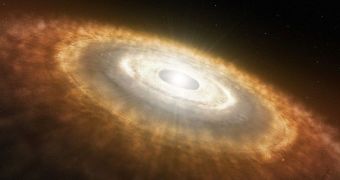In a paper scheduled to appear in an upcoming issue of the Astrophysical Journal, astronomers sought to identify the exact conditions that need to be fulfilled in the region around a newly-formed star, so that planets could begin to form.
The main conclusion of the study is that star systems with higher metallicities are the most likely to promote the development of new planets. Metallicity is a measure of how many chemical elements heavier than hydrogen and helium are found in and around the star, and in what concentrations.
It is well known that chemicals heavier than helium and hydrogen are only produced within stars, and that they are spread throughout the Universe when these objects go supernova. As such, it stands to reason that each generation of new stars is more likely to form planets than the one before.
Oxygen, silicon, and iron are the primary, heavier elements needed to form new worlds. Under the “core accretion” model, small grains of dust provide the nuclei around which other particles cling, eventually leading to the formation of planetesimals.
These are small rocks that are made up of heavy chemicals. The cosmic dust that provides their foundation cannot form without silicon, for example. In addition, star systems with a lower metallicity have been shown to lose their accretion disk faster than normal.
The accretion disk is a circular structure that forms around a new star. It is made up of the material that was originally a part of the molecular cloud that spawned the star. The material did not collapse into the object during its formation. The motion of the star causes the disk to start spinning.
This motion favors the interaction of dust grains, and the formation of planetesimals. “Our calculation is an estimate of the minimum amount of heavy elements that must be present in circumstellar disks before planets can form,” expert Jarrett Johnson explains, quoted by Astrobiology Magazine.
“Because these heavy elements must be produced by the first stars in the universe, the first planets could only form around later generations of stars,” the research team member goes on to add.
Johnson and colleague Hui Li are the leaders of the new study. They are based at the US Department of Energy's (DOE ) Los Alamos National Laboratory (LANL).
“A planet as massive and dense as the Earth could only form once stars and supernovae had enriched the gas with an abundance of heavy elements that is at least 10 percent that in the Sun,” Johnson says.
“This suggests that many generations of stars had to form and evolve before habitable planets could form,” the expert concludes.

 14 DAY TRIAL //
14 DAY TRIAL //